The Fascinating World of Talking Birds Revealed
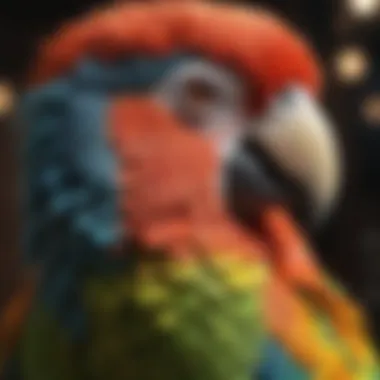
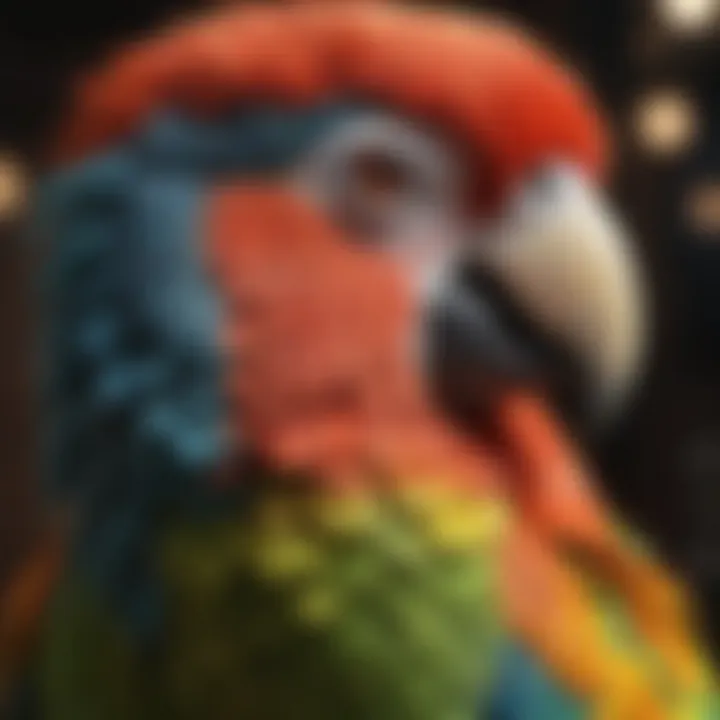
Intro
Talking birds are a fascinating subject that combines aspects of linguistics, animal behavior, and companionship. These remarkable creatures, known for their ability to mimic human speech and sounds, capture the interest of many. Understanding these birds requires an exploration of their unique vocal talents and cognitive functions. Moreover, caring for them properly is crucial for both their well-being and the enjoyment of their human companions. In this article, we will discuss various species of talking birds, delve into their communication abilities, and highlight the necessary care routines, behavioral insights, nutrition needs, wellness considerations, and engaging activities that enhance their lives.
Care Tips
Caring for a talking bird is beyond just feeding. It involves creating an environment that supports their physical and mental health. Here are some essential aspects of daily care:
Daily Care Routines
Establishing a consistent daily routine is vital for the well-being of your feathered friend. This can include:
- Morning Rituals: Easing them into the day with gentle talking or singing can help them acclimate.
- Feeding Schedule: Offering high-quality bird food at the same times daily promotes healthy digestion.
- Socialization: Spend time with your bird each day. Interaction is crucial for their emotional health.
Cage Setup and Maintenance
The cage serves as a sanctuary for your bird. Key considerations include:
- Size and Space: Ensure the cage is spacious enough for them to fly short distances.
- Location: Place the cage in a busy area of your home for social stimulation, yet away from direct sunlight and drafts.
- Accessories: Include perches, toys, and food/water dishes. Change them regularly to prevent boredom.
Hygiene and Cleaning Practices
Maintaining cleanliness is essential for preventing diseases. Here’s how to keep the cage clean:
- Regular Cleaning: Remove waste daily and do a deep clean weekly, using bird-safe cleaning supplies.
- Bedding Changes: Replace any bedding materials regularly to reduce odors and mess.
Seasonal Care Adjustments
Note that as seasons change, so do the needs of your talking bird. In winter, ensure they are warm and protected from cold. In summer, provide shade and plenty of fresh water.
Behavioral Insights
Understanding the behavior of your talking bird is essential for a healthy relationship.
Understanding Bird Body Language
Birds communicate their feelings through body language. Pay attention to:
- Feather Position: Fluffed feathers can indicate discomfort or being cold.
- Head Movements: Tilting may show curiosity or an attempt to hear better.
Common Behavioral Issues and Solutions
Behavioral issues can arise, such as excessive screeching or biting. Common approaches include:
- Identifying Triggers: Observe when these problems occur to address the cause.
- Consistency: Use consistent commands and reactions during training.
Positive Reinforcement Techniques
Utilizing positive reinforcement encourages good behavior. Reward your bird with treats for desired actions, promoting a bond built on trust.
Social Interaction Needs
Talking birds are social creatures. Regular interactions are necessary to prevent loneliness and boredom, which can lead to behavioral problems.
Nutrition Guides
A proper diet is fundamental for the health of your bird. Here’s a quick rundown of nutrition:
Essential Diet Components
A balanced diet typically includes:
- Seeds and Pellets: These serve as staples in their diet.
- Fruits and Vegetables: Fresh produce enriches their meals and provides vitamins.
Safe and Toxic Foods
It is crucial to know what foods are safe. For instance:
- Safe Options: Apples, carrots, and leafy greens are great choices.
- Toxic Foods: Avoid avocado, chocolate, and caffeine as they can be poisonous.
Supplements and Treats
Certain supplements can enhance their diet. Bird-safe vitamins may be beneficial. Treats should be offered sparingly and should never replace nutritious meals.
Feeding Strategies for Different Species
Different species have varying dietary needs. Be sure to research the specific requirements of the bird species you own to ensure they thrive.
Wellness and Health
Monitoring your bird's health is critical. Regular evaluations will help maintain their well-being.
Routine Health Checkups
Schedule regular visits to an avian veterinarian to ensure your bird remains in good health. Early detection of any issues can make a tremendous difference.


Identifying Symptoms of Illness
Be wary of any changes in behavior such as lethargy, changes in appetite, or feather plucking. Addressing these signs early can prevent serious issues.
Preventative Care and Vaccinations
Vaccinations may be necessary depending on the species. Work with your vet on a preventative care plan.
Mental and Emotional Well-being
Birds thrive when they are mentally stimulated. Ensure they have access to toys and interaction to promote their emotional health.
Enriching Activities
Engaging your talking bird is vital for their development.
Toys and Playtime Ideas
Invest in a variety of toys. Rotate them to keep your bird entertained and mentally stimulated.
Training and Tricks
Training sessions also allow birds to learn new skills and tricks, enhancing their cognitive functions. Short, consistent training sessions work best.
Outdoor Activities and Interaction
Supervised outdoor time can provide new experiences and sounds, enriching your bird's world significantly.
DIY Projects for Mental Stimulation
Consider making your own bird toys from safe materials at home. It's a fun activity that can also save money while keeping your bird engaged.
Prelude to Talking Birds
Talking birds occupy a unique place in both our homes and cultural narratives. These fascinating creatures, often cherished as companions, possess vocal skills that intrigue many. Their ability to mimic human speech and sounds is not merely a novelty; it reflects a complex interplay of biology and behavior. Understanding these aspects can greatly enhance the experience of owning a talking bird, ensuring responsible pet ownership.
Definition and Characteristics
Talking birds are species known for their ability to mimic sounds, particularly human speech. Key characteristics include a specialized vocal organ called the syrinx. This unique anatomy gives them the flexibility to produce various sounds. Additionally, cognitive abilities play a significant role in their mimicking capabilities. Birds like African Grey Parrots exhibit advanced problem-solving skills and social learning.
Common talking birds include:
- Parrots (such as the African Grey and Budgerigar)
- Myna Birds
- Magpies
Each species has its own distinct personality traits and vocal skills. Understanding their behavior provides insights into their needs and habitat, which is essential for any potential bird owner.
Historical Significance in Human Culture
The connection between humans and talking birds has deep historical roots. Civilizations across the globe have revered these birds, often associating them with wisdom, companionship, and even spiritual significance. In ancient Egypt, for example, some birds were kept as pets and symbols of status. In the 18th and 19th centuries, keeping talking birds became popular among the wealthy as a means of demonstrating education and social standing.
Throughout history, the wonder of their mimicry has appeared in literature and folklore. Stories often depict these birds as intermediaries between the human and animal worlds, able to convey messages and wisdom. This long-standing relationship emphasizes the cultural importance of talking birds and continues to encourage people to bring them into their lives as beloved pets.
Species of Talking Birds
The study of talking birds encompasses various species renowned for their vocal skills. Recognizing these species is crucial to understanding the capabilities and needs of these feathered companions. Each bird species presents unique traits and levels of intelligence that contribute to their ability to mimic human speech. For potential pet owners, being informed about these differences can guide decisions that align with the owner’s lifestyle and expectations.
Parrots
Parrots are commonly celebrated as the most proficient talking birds. Their ability to learn and replicate words and phrases makes them popular among bird enthusiasts. Every species of parrot has distinct vocal characteristics that can enhance their desirability as pets.
African Grey Parrots
African Grey Parrots are particularly noted for their exceptional vocal skills. These birds are often viewed as one of the most intelligent avian species. They possess a remarkable ability to mimic not only words but also tones and inflections. This adaptability can lead to rich interactions between the bird and its owner.
One key characteristic of the African Grey is its strong desire for social interaction. These birds thrive in environments where they receive ample attention, which makes them both endearing and at times demanding. Their intelligence can also lead to potential behavioral issues if not adequately stimulated. Their distinct grey feathers and bright red tails add a visual appeal, making them a favored choice among bird lovers.
However, they have specific dietary needs and social requirements that must be prioritized for their well-being. This makes ownership both rewarding and challenging.
Amazon Parrots
Amazon Parrots exhibit a playful nature and can become strong conversationalists with the right encouragement. These parrots are notable for their robust body structure and vibrant plumage. Known for their engaging personalities, they can quickly learn a variety of sounds and words.
The key feature of Amazon Parrots is their extroverted demeanor. They often enjoy being the center of attention and can mimic not just human speech but also environmental sounds. This ability to imitate creates entertaining dynamics within a household.
Yet, potential owners should be aware of their loud vocalizations, which can be an issue in some living situations. They require proper mental stimulation and social interaction to prevent boredom-induced habits, which can manifest as misbehavior.
Budgerigars
Budgerigars, often referred to as budgies, are smaller parrots that make excellent companions. Their cheerful appearance and approachable nature contribute to their status as one of the most popular pet birds worldwide. Despite their size, they can develop a decent vocabulary.
A notable characteristic of budgerigars is their ability to learn quickly and engage with their owners. They require less space and can adapt well to various environmental conditions. Budgies are often seen as ideal for first-time bird owners due to their relatively lower maintenance needs compared to larger parrots.
However, they should not be underestimated in terms of vocal ability. They can be quite chatty and require social interaction to remain mentally stimulated. Their smaller size also means they are generally less demanding in terms of space and diet, making them a practical choice for many.
Myna Birds
Myna birds are lesser-known talking birds, yet they possess impressive mimicry skills. Their ability to echo human speech and various sounds makes them intriguing pets. These birds display a playful attitude and demand attention from their owners.
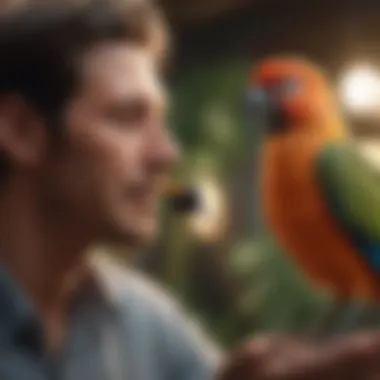
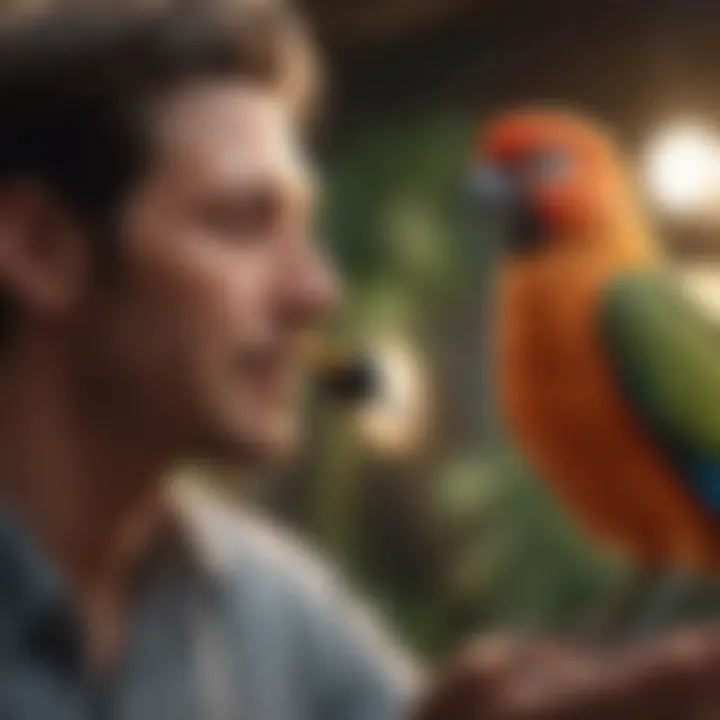
The mynas' adaptability to different environments allows them to thrive in captivity. They are social birds that enjoy engaging with their caretakers. However, potential owners must consider their social needs and real commitment to singing and vocalization activities.
Magpies
Magpies are another fascinating species when discussing talking birds. While primarily recognized for their intelligence, these birds can also mimic sounds effectively. They are not as traditionally kept as pets, but their vocal talents make them interesting in the pet ownership conversation.
The unique behavioral patterns of magpies should be noted. They are known to form strong bonds with their owners. However, their potential to become aggressive if threatened can be a downside for some people. Their intelligence is a double-edged sword, providing companionship while also needing mental challenges to prevent destructive behavior.
In summary, species of talking birds exhibit a variety of characteristics that can cater to different pet owner preferences. From the intelligent African Grey to the playful Budgerigar, each species has its charm and challenges. Educating oneself about these birds is essential for maximizing their potential and nurturing a beneficial owner-bird relationship.
The Science Behind Vocal Mimicry
Talking birds are fascinating because they exhibit vocal mimicry, a behavior that showcases their remarkable abilities. Understanding the science behind this mimicry is essential for bird owners and enthusiasts. It sheds light on how these birds communicate, learn, and interact with their surroundings. Additionally, by grasping vocal mimicry's complexities, one can enhance their approach to caring for these birds, ensuring a more fulfilling relationship.
Anatomy of Bird Vocalization
Bird vocalization is a sophisticated process involving specialized anatomical structures. The primary organ responsible for producing sounds in birds is the syrinx. Unlike mammals, which use the larynx, birds have their syrinx located at the base of their trachea. This unique structure allows for a diverse range of sounds.
The syrinx's muscles control tension, airflow, and resonance, facilitating varied tonal qualities. It can create simultaneous sounds, enabling birds to produce complex vocalizations. Understanding this anatomy helps bird owners appreciate the intricate nature of their pets' vocal talents. There are also resonating chambers in birds' vocal tracts that modify sound produced by the syrinx, affecting volume and quality.
Caring for a talking bird involves recognizing how their physical traits enable communication. By knowing how sound is produced, owners can help to stimulate vocalization through proper environmental factors such as spacious living conditions and appropriate social interactions.
Cognitive Abilities Required for Mimicry
Cognitive abilities play a crucial role in vocal mimicry. Birds that exhibit talking behavior often possess advanced neural structures. Studies shows that species like African Grey Parrots demonstrate problem-solving skills and memory retention which enhance their ability to mimic sounds.
Birds learn through listening and repetition. They can associate sounds with specific meanings, a significant aspect of complex vocalization. This ability indicates their social nature, as they often mimic sounds they associate with their environment or human caregivers.
For pet owners, understanding these cognitive processes is vital. Engaging birds with interactive communication can foster their learning capabilities. Activities such as talking, playing sounds, or offering rewards for vocalization can boost their mimicry skills.
A study observed that African Grey Parrots could learn and recall over 100 words, showcasing their remarkable capacity for vocal mimicry.
Behavioral Aspects of Talking Birds
Understanding the behavioral aspects of talking birds is essential for anyone looking to keep these creatures as companions. The behavioral traits of these birds offer insight into their needs and how they interact with humans and their environment. It underscores the importance of fostering a stimulating atmosphere for their emotional well-being and overall health.
These birds often exhibit complex social behaviors, which are integral to their communication skills. Their need for social interaction is pronounced, and it directly influences their ability to thrive in captivity. Knowing the intricacies of their behavior can enhance the experience of bird ownership, as it enables owners to create a nurturing setting that combines engagement and security.
Social Interaction and Communication
For talking birds, social interaction is paramount. In the wild, many species like African Grey parrots and budgerigars live in flocks. This natural tendency drives their need for companionship and communication. When kept in captivity, they strive for similar connectivity with their owners.
Social interaction fulfills several functions:
- Emotional Well-being: Engaging with their human companions helps alleviate boredom and provides comfort, which can be crucial for their mental health.
- Vocal Development: Conversations foster vocalization. Birds mimic sounds and words better when they are in a stimulating environment. Their inherent desire to communicate often leads them to repeat words and phrases they hear regularly.
- Bonding: Regular interaction fosters stronger bonds between the bird and owner. This connection is vital for the bird’s happiness and for encouraging trust.
In addition, the type of communication varies widely among the talking birds. Parrots often use a variety of pitches and tones, displaying their emotions through vocal cues. It is beneficial for owners to be attentive to their bird's sounds to understand their needs better.
Learning Processes in Captivity
Learning is a fundamental aspect of a talking bird's life. In captivity, these birds must adapt to their owners' routines and environments. Understanding their learning processes can greatly enhance their adaptability and overall happiness.
- Repetition and Reinforcement: Like many animals, talking birds learn through repetition. When they hear a phrase often enough, they start to mimic it. Positive reinforcement, such as treats or praise when they repeat a word correctly, proves effective in this process.
- Observational Learning: Birds are inherently curious and often learn by observing their human companions. This type of learning underscores the importance of the environment they are in. Owners should strive for a dynamic space that encourages exploration and interaction.
- Social Learning: The company of other birds can motivate learning. If one bird sees another successfully complete a task, it may try to mimic that behavior, further enhancing its skills.
Care Requirements for Talking Birds
Caring for talking birds encompasses several critical factors that contribute to their well-being. These requirements are not just about providing food and shelter. Instead, they play a significant role in ensuring that these intelligent beings thrive in a home environment. Understanding the nutritional needs, appropriate housing conditions, and health monitoring will aid pet owners in fostering a happy and healthy life for their feathered companions.
Nutritional Needs
Talking birds require a well-balanced diet for optimal health. Their diet should consist of a variety of seeds, nuts, fruits, and vegetables. Each species may have specific nutritional demands. For instance, African Grey Parrots benefit from pellets that are rich in vitamins and minerals.
Special attention must be given to:
- High-quality pellets: These are formulated to meet the dietary requirements of birds and should make up a significant portion of their diet.
- Fresh fruits and vegetables: These provide essential vitamins and hydration. Examples include carrots, spinach, apples, and berries.
- Limited treats: While birds enjoy snacks, they should be given in moderation to prevent obesity.
Ultimately, consulting a veterinarian experienced in avian care can provide specific recommendations tailored to each species.
Housing Considerations
The physical environment of talking birds is crucial for their mental and physical health. Housing should replicate natural conditions as much as possible to promote comfort and reduce stress. Here are some important factors to consider:
- Cage size: A larger cage is always better. Birds require space to stretch their wings and move around. The ideal cage should allow them to flap their wings without restriction.
- Cage accessories: Include perches of varying sizes, types of toys, and climbing structures to provide stimulation. These can also prevent boredom and help develop their natural behaviors.
- Location: The cage should be placed in a quiet yet engaging part of the home, away from direct sunlight and drafts. Birds are social animals and should be housed in a location where they can interact with family members.
Health and Wellness Monitoring
Regular health monitoring is essential to identify any potential issues early. Talking birds can hide illness effectively, making it crucial for owners to be observant. Vital aspects of health monitoring include:
- Routine check-ups: Schedule annual vet visits for health assessments and vaccinations. The veterinarian can provide valuable insights into the bird's health and recommend preventative care.
- Behavioral observation: Owners should pay attention to behavioral changes. Sudden shifts in eating habits or vocalizations could indicate health issues.
- Feather and skin condition: Healthy feathers and skin can tell a lot about a bird's overall health. Regular grooming and monitoring for signs of irritation or plucking are important.
"Successful bird care is not just about meeting basic needs but ensuring a holistic approach to their environment, diet, and health."
By adhering to these care requirements, owners can help create a stable environment that nurtures their talking birds, fostering a strong bond and enriching both the bird's life and the owner's experience.
Enrichment Activities for Talking Birds
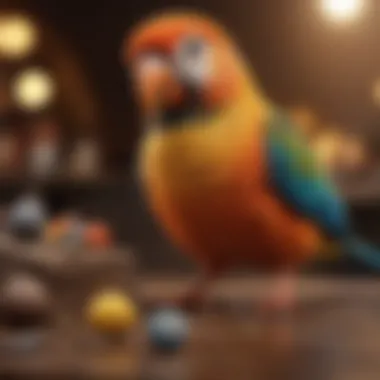
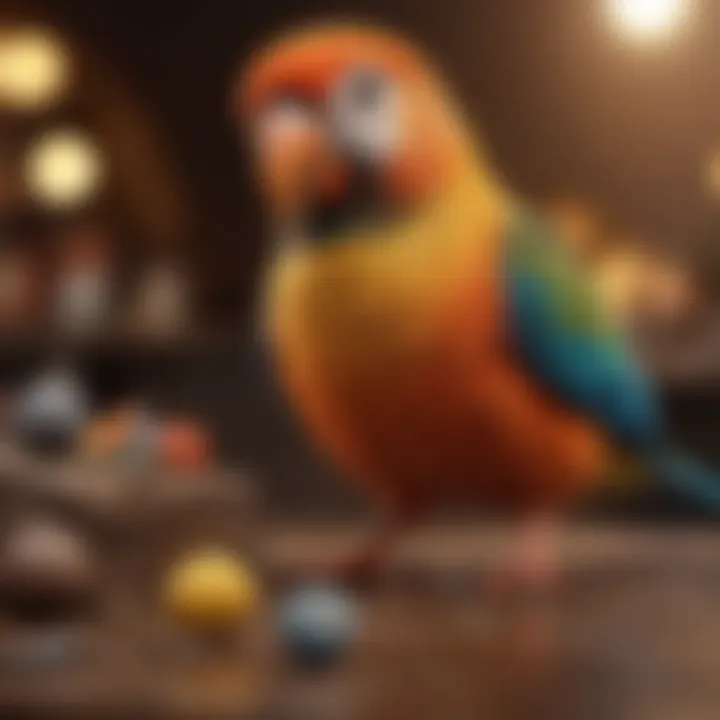
Enrichment activities are critical for the health and well-being of talking birds. These activities stimulate physical, mental, and social engagement, promoting a fulfilling life. Birds are intelligent creatures, and they require various forms of stimulation to prevent boredom, which can lead to undesirable behaviors.
Benefits of Enrichment Activities
Engagement through enrichment helps in several ways:
- Mental Stimulation: Activities keep the birds intellectually engaged. They must think critically when solving problems or interacting with toys.
- Physical Health: Many methods involve physical activity. Climbing, moving, and playing contribute to overall fitness.
- Behavioral Balance: Proper enrichment reduces stress and frustration. Birds with access to varied activities are less likely to develop behavioral issues, such as feather plucking.
Effective enrichment can be categorized into different types. Some are focused on movement and activity, while others require cognitive effort. Fulfilling both needs is crucial.
Interactive Toys and Games
Interactive toys can greatly enhance a talking bird's quality of life. Toys that require manipulation can facilitate various forms of play, which birds enjoy.
- Types of Toys:
- Puzzle Toys: These toys often feature compartments that hold treats or seeds. The bird must solve the puzzle to access the food. This challenges their cognitive abilities.
- Foraging Toys: These are designed to encourage the bird to search for food within the toy. It mimics natural foraging behavior. Incorporating these toys in daily life keeps birds engaged and active.
- Swinging and Climbing Toys: These types encourage physical movement. They enable birds to exercise and build muscle while having fun.
It's essential to rotate toys regularly to maintain the birds’ interest and prevent them from losing enthusiasm.
Training Techniques for Enhanced Interaction
Training talking birds can lead to meaningful interactions. This not only builds a bond with the owner but also promotes exercise and mental challenge for the bird.
- Positive Reinforcement: Utilize treats or praise to encourage desired behavior. This method increases the likelihood of the bird repeating good behaviors.
- Socialization: Expose the bird to various people and environments. This helps them adapt to different scenarios and reduces stress.
- Target Training: Teach birds to follow a target stick. This method helps them learn to come back when called and engage more during playtime.
Training should be consistent but patient. A gentle approach helps build trust between bird and owner.
Engagement through playful interaction can promote a deeper connection, resulting in a more enriching experience for both the bird and the owner. By focusing on interactive toys and training techniques, owners can elevate the lives of their talking birds significantly.
Challenges of Owning a Talking Bird
Owning a talking bird can be a rewarding experience, yet it brings distinct challenges that potential bird owners must consider. This section highlights important factors that come into play when deciding to adopt and care for a talking bird. Awareness of these challenges helps ensure a harmonious relationship between the bird and its owner. It is crucial for pet bird owners, aspiring bird parents, and breeders to recognize and prepare for these difficulties to foster a healthy and enriching environment.
Behavioral Issues
Behavioral issues are one of the most significant challenges faced by talking bird owners. Birds are intelligent creatures that can experience boredom, anxiety, or frustration if their needs are not met. Problems such as excessive screaming, feather plucking, or aggressive behavior may arise if the bird feels neglected or stressed. These behaviors are not just nuisances; they reflect a bird's emotional state and its need for stimulation.
Common behavioral issues include:
- Screaming: Birds often vocalize loudly, especially when they seek attention.
- Aggression: In some instances, a bird may become aggressive towards its owner or other pets.
- Destructive behavior: Chewing on furniture or toys can indicate boredom or frustration.
To mitigate these issues, an owner must invest time in understanding their bird’s habits and needs. Engaging the bird with varied activities, offering toys designed for enrichment, and maintaining a consistent routine can help improve their psychological well-being.
Time Commitment and Attention Needs
The time commitment required for talking bird care cannot be overstated. Birds crave social interaction and mental engagement. Leaving them alone for extended periods can lead to loneliness and behavioral problems. Unlike traditional pets, birds thrive on companionship and will often bond closely with their human caregivers.
Key considerations include:
- Daily interaction: Birds need daily playtime and interaction to develop trust and a strong relationship with their owner.
- Training time: Training sessions can be beneficial for both bird and owner but require additional commitment to be effective.
- Supervised free time: Allowing a bird to explore outside their cage in a safe environment is crucial, but it requires vigilance.
The Ethics of Keeping Talking Birds
The ethical considerations surrounding the keeping of talking birds are significant. These avian creatures possess remarkable intelligence and social needs. Therefore, understanding how to responsibly engage with them is crucial for pet owners and society at large. This section discusses the implications of keeping talking birds, emphasizing the difference between wild and captive life.
Considerations for Wild vs. Captive Birds
When discussing talking birds, it is essential to differentiate between their life in the wild and as domesticated pets. Wild birds, such as many species of parrots, thrive in their natural habitats. They interact freely with their environments, forming complex social structures and engaging in behaviors critical to their survival and reproduction. High levels of stimulation and freedom are vital for their well-being.
While captive birds can experience a good quality of life, they often face limitations. Factors like confined spaces, lack of companionship, and inadequate mental stimulation can lead to stress and behavioral issues. Pet owners need to ensure that their birds receive proper enrichment, such as toys, social interaction, and playtime. Understanding bird behavior is critical for reducing stress and fostering a fulfilling life for these animals in captivity.
Ethically, it is necessary for potential bird owners to consider adopting captive-bred birds instead of taking from the wild. This helps in preventing the decline of wild populations and supports captive breeding programs aimed at conservation.
Contributions to Conservation Efforts
Conservation is deeply intertwined with the ethics of keeping talking birds. Many species of talking birds are threatened or endangered due to habitat loss, poaching, and the illegal pet trade. By advocating for responsible ownership and supporting conservation programs, bird enthusiasts can play a positive role in protecting these remarkable animals.
Many organizations work to rehabilitate wild birds and educate the public. By fostering public awareness, these initiatives help highlight the importance of maintaining wild populations and ensuring healthy environments.
For instance, the African Grey Parrot is a species often seen in captivity. However, its population is declining in the wild. Supporting groups that focus on habitat restoration can benefit these birds significantly.
Inclusion of captive birds in educational programs can also contribute positively. They can be ambassadors for their wild counterparts, teaching people about their behaviors, needs, and the importance of conserving their natural habitats.
Epilogue: The Role of Talking Birds in Human Lives
Talking birds forge unique bonds with their human companions. These relationships often transcend simple pet ownership. The act of talking, mimicking human speech and sounds, serves as a bridge between species. It encourages understanding and strengthens the emotional ties between people and birds.
Fostering Relationships and Understanding
Connecting with a talking bird can be a transformative experience. Many bird owners report enhanced happiness and companionship. The ability of a bird to mimic specific phrases or sounds can lead to engaging interactions.
Some key aspects of fostering relationships with talking birds include:
- Communication: Birds can learn to associate words with actions or feelings. For example, a bird saying "hello" often results in a positive reaction from its owner.
- Routine: Establishing a regular schedule for interaction can create anticipation for both the owner and the bird.
- Socialization: Talking birds often enjoy being around their owners. This can reduce feelings of loneliness for both parties. Owners may feel more connected to their birds, who reciprocate with attention and vocal responses.
"The more you engage with your talking bird, the more they respond and interact. It's a dynamic conversation that brings both joy and understanding."
Future Perspectives in Avian Companionship
The world of talking birds is likely to evolve. As understanding of their needs and abilities deepens, better practices for care and interaction will emerge. Advances in technology may play a role in how people connect with their birds.
- Innovative Training Techniques: Future training methods could be tailored using modern psychology principles, making it easier for bird owners to teach their pets.
- Health Monitoring: With developments in veterinary science, there will be enhanced ways to monitor the health and wellbeing of talking birds, benefiting both the birds and their human companions.
- Community Engagement: More forums and platforms, such as discussions on Reddit or Facebook, will allow owners to share experiences and improve understanding.
In summary, talking birds hold a significant place in the lives of many people. Their ability to communicate fosters relationships that enrich both human and avian experiences. With a better grasp of their requirements, people can ensure a more fulfilling companionship.















